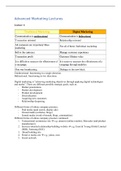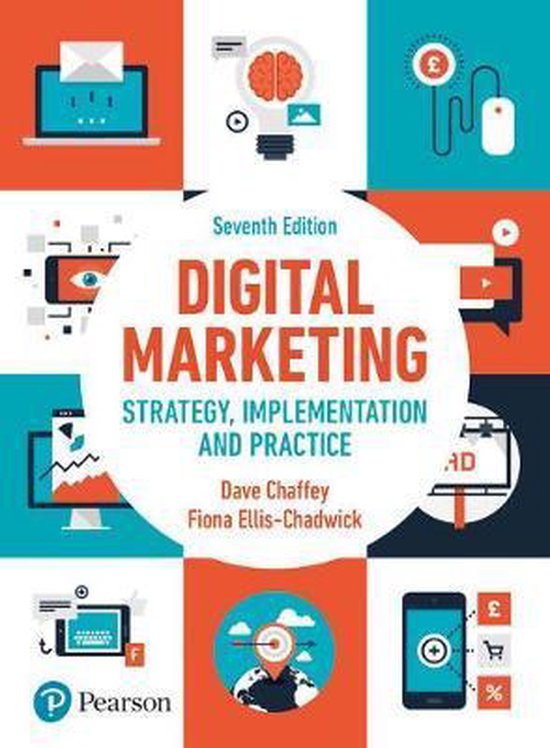Advanced Marketing Lectures
Lecture 1:
Unidirectional: functioning in a single direction.
Bidirectional: functioning in two directions.
Digital marketing is “achieving marketing objectives through applying digital technologies
and media”. There are different possible strategic goals, such as:
- Market penetrations
- Market development
- Product development
- Diversification
- Acquiring new customers
- Relationship deepening.
Different forms of online company presence:
- Paid media (paid search, display ads)
- Owned media (websites, blogs)
- Earned media (word-of-mouth, blogs, communities)
Different forms of online company presence continued:
1. Transactional ecommerce site e.g. amazon (online retailer), Mercedes (end-product
manufacturer)
2. Services-oriented relationship-building website e.g. Ernst & Young Global Limited
(B2B), Samsung (B2C)
3. Brand building site
4. Portal or media site e.g. yahoo, msn
5. Social network.
,Key online activities that need to be managed as part of digital marketing:
Using digital channels to support business objectives:
1. Reach involves building awareness of a brand, its products and services on other
websites and in offline media in order to build traffic by driving visits to different web
presences (using different paid, owned and earned media touchpoints).
2. Act engage interactions on websites and in social media to generate leads is a big
challenge for online marketers.
3. Convert this is conversion to sale. It involves getting your audience to take that
vital next step which turns them into paying customers both online and offline.
4. Engage developing a long-term relationship with first-time buyers to build
customer loyalty as repeat purchases using communications on you site, social
presence, e-mail and direct interactions to boost customer lifetime value.
Digital marketing helps companies by:
- Identifying understand customer needs and wants
- Anticipating additional channel that helps customers to access information and to
make purchases
- Satisfying better customer relationship management (e.g. interaction).
Challenges (CCRRA):
- Complexity (personalization, testing and dynamic variation in ads)
- Responding to competitors (more resources to monitor competitor activities)
- Responding to changes in technologies (low level of training)
- Cost (really high, exceeding 10EU per click)
- Attention (banner blindness, consumers do not see advertisement).
, Key take aways:
- Digital marketing tries to reduce the gap between companies and customers
- Digital marketing channels can be used to support business’s both online and offline
goals
- The effectiveness of different forms of online company presence depends on the type
of business.
Lecture 2:
MACRO:
Important questions:
- How relevant is the behavior of the actors in the macro environment to the future of
our business?
- How is the digital macro environment different from traditional marketing
environment?
PESTLE political, economic, social, technological, legal, environmental.
1. Political forces: governance, taxation
2. Economic forces: demographic variables age profile, education level, gender
3. Social and cultural forces: the beliefs, customs and standards held by customers. who
may be of a different faith, race and socio-economic background to your average
customer internet usage habits
4. Technological forces: changes in technology that influence marketing opportunities:
a. Web browser (display information and allow users to access websites):
i. Google chrome
ii. Microsoft internet explorer
iii. Apple safari
iv. Mozilla Firefox
b. Web addresses (used to find a web page): a domain name is the name of a
website. A URL (Universal Resource Locator) is a complete web address
used to find a particular web page. While the domain is the name of the
website, a URL will lead to any of the pages within the website. Buying a
domain name doesn’t mean you have a website. It’s just the name of a website,






